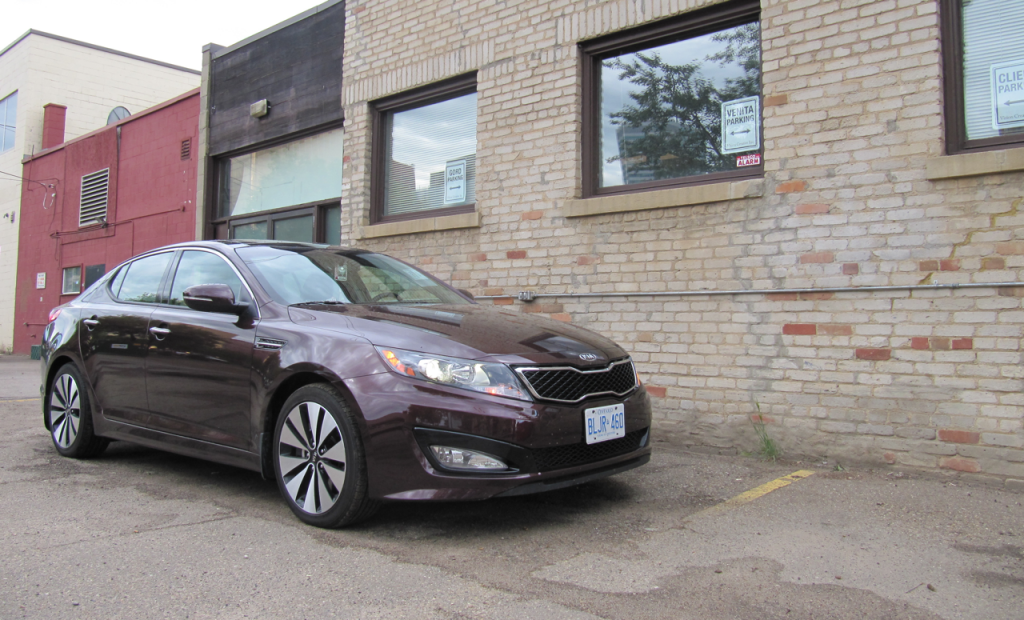2.0T
That’ll be an Audi with the ubiquitous two-litre TFSI engine, then. “Not so fast”, says Kia, a subsidiary of South Korean monolith Hyundai. “It’s a Kia”, they continue, in much the same way that every Optima owner will, on a daily basis, no less. Had Kia actually slapped a “2.0T” badge on the back, instead of the GDI-T (denoting Gas Direct Injection – Turbocharged), Audi would, believe it or not, blush at the comparison.
Even though Audi’s new EA888 has upped its game to 211hp and 258lb-ft, the GDI-T utterly trumps that with 274hp and 269lb-ft thanks to direct injection, a sizeable intercooler, and a twin-scroll turbocharger. That Kia badge is suddenly less funny. But where the Audi is all-wheel drive, the Optima is resolutely a front driver. This important difference ensures that the Optima will be rightly compared to the likes of Honda’s Accord and Ford’s Fusion, rather than the more premium nameplates its sultry lines suggest.
Power is routed to those character-defining front wheels through the standard 6-speed automatic, developed in-house, which handles the boosty power delivery assuredly. Paddle shifters behind the steering wheel casually target ratios with all the self-important indifference of snooty British Royalty, which is to say that they can’t be bothered to work. This is probably for the best, because the Optima doesn’t ask its driver to grab it by the scruff of its neck and give it a good shagging, it asks the driver to feel good because he looks good, but more on the looks in a minute. The steering is partly to blame for the lack of enthusiasm; it has some heft to it, but its inaccuracy means that it doesn’t mask the size of the vehicle as well as the small-diameter rim might suggest.
The ride is evenly measured, but rebound is a bit sharp around town, giving the car a sporting pretension it would be better served to ignore. The ride paces itself better on the highway, where the on-boost turbo dismisses lesser Korean fare with a flick of the toe. The engine and exhaust notes are also appropriately relaxed at highway speeds, which means no energy-sapping droning and a fresh-feeling driver at the other end. More demure, but suitably rapid, progress is the modus operandi. The Optima Turbo would be perfect on a road trip, like the one we did to Winnipeg in March.
Sized comparably with the kingly BMW 5-series, and actually slightly lower in height, the Optima eschews its mundane mainstream competitors and lunges straight for the jugular of German Royalty, at least on the surface. Based on the KND-5 Concept, the design of the suave sheetmetal, respectable rubber, and leathery leathers owes much to its German designer, a man evidently fond of German (car) porn and hellbent on bringing it East. The Optima is just plain handsome, and were it to wear a less stigmatized logo, it would be stacking sales titles left, right, and centre. It’s no easy task to sketch a unique design when safety regulations are so imposing and the platform is being donated by the Hyundai Sonata, but the stretched headlights, clean side profile, and bejeweled taillights conspire to bring a newfound sense of elegance to the brand.
The interior is similarly accomplished. In the tested top-spec SX, the capacitive touchscreen zipped from menu to menu so little commotion that it made MyFordTouch seem like an anachronism. The Optima might as well be an iPad to the MFT’s Windows 97. The favourably sized, easily legible navigation buttons nestled beneath the touchscreen made operation of the myriad functions all the more intuitive. The twin glass roofs made for an airy and light-filled commode – a pleasant place to spend time whether in front or in back.
The front heated and cooled seats are cosseting but low on side support, with fine mesh detailing that looks at once sporting and upscale. The rear heated seats are only 1-stage, but that they’re standard equipment on a $35,000 vehicle is democratization of luxury at its best. Truly, the Optima’s meteorological mastery of seating is a shot clear across the bow of the Kriegsmarine ship German Royalty.
Despite the technology, Kia claims a weight of only 3,385lbs, or about as much as a NASCAR race car. Perhaps that’s a useless comparison, or perhaps not. Because race car. Kidding! One has a nav screen, leather, and electric everything, while the other has a tin body, safety equipment, and a V8. The trade-offs apparently balance each other out.
Fuel economy leaves something to be desired, but driving turbo cars aggressively will do that. Just ask an Evo X owner. We saw 14L/100km with 80% city driving and 20% highway.
Based on the above, “2.0T” obviously doesn’t mean what it used to, and Kia is certainly on the right track as it explores new arenas of performance, but the shrewdest choice in the line-up isn’t the most expensive.
The linearity of the naturally aspirated two-litre engine in the lesser Optima is more than sufficient and is the midsize sedan buyer’s best bet. It produces as much horsepower as the MkV GTI and does so without the German’s turbo. Amazing, when you put it in perspective. The fuel economy of the NA Optima also has a slightly better mileage rating, but would likely distance itself even further in the real world since there’s no turbo to indulge in.
So here’s your CarEnvy Top Tip: Skip the SX Turbo. Buy the EX Luxury with Navigation and you’ll save yourself $1600, get the standard suspension instead of the too-jumpy sport suspension, better fuel economy, and best of all, no paddle shifters.
Envy Factor: 8/10

